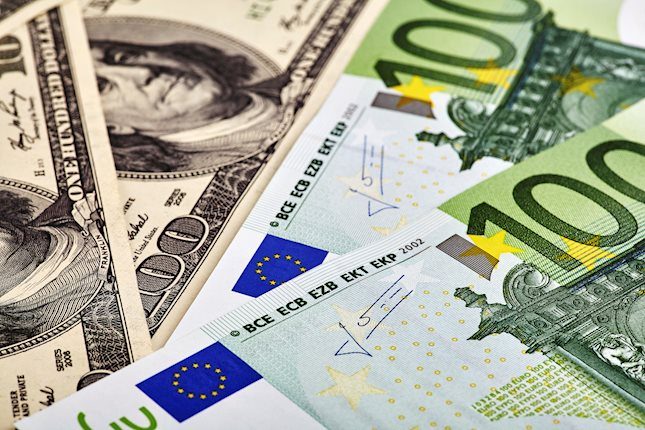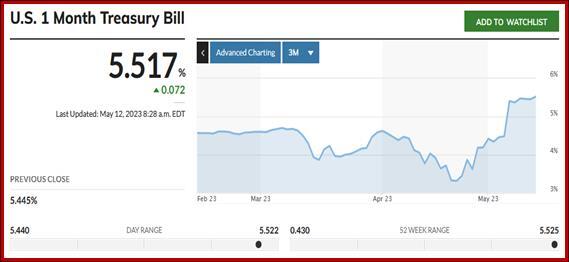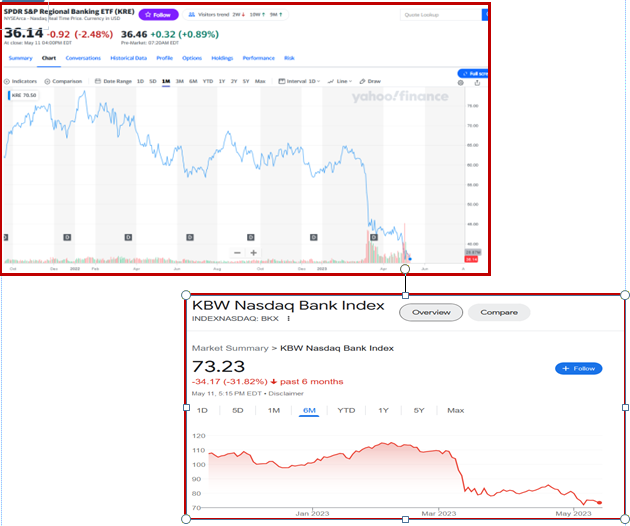Outlook: The dollar seems to be firming on risk aversion, which is all too easy to identify and understand. We do have a crisis brewing in the regional bank space and of course then there is the debt ceiling crisis, plus mayhem at the Mexican border and far too many guns.
We keep repeating that statistically, the US doesn’t have more crazy people than anyone else. The curve is normally distributed. It’s just that our crazy people all have guns. New Zealand is the model here—no more guns, no more mass shootings. Plus, aside from Italy’s Berlusconi, no other country has a dangerous jackass like Trump. The UK got rid of its buffoon.
But not one of the repulsive things about the US can hold a candle to 1-month t-bills offering over 5.5% return, something you usually need to go to an unreliable EM to get. Is it that simple? Yes, probably. We can’t find any other reasons as compelling.
Forecast: If we decide the rising dollar is a function of risk aversion/flight to safety and/or flight to juicy short-term returns, it’s only logical that when the debt ceiling issue is fixed, the dollar and 1-month T-bill will collapse. The big risk is that the dollar bulls will pull in their horns ahead of the weekend when a deal could get done.
However, this seems unlikely. We suspect we will have the same crisis mentality next week. It will be beyond the middle of next week when the White House will choose one of the less-ideal solutions, having gained the time to make the point that it’s the intransigent Congress at fault.
Nobody will remember this at the ballot box in 2024 so it’s not the smartest political strategy, but tigers and stripes. If Pres Biden does get a compromise deal, he can then use it to emphasize his decades-long experience in compromises and the “wisdom” of being old, as he has said. Either way, it’s a win-win for Biden, or so he thinks. The finance world blows a raspberry to all this political junk.
Tidbit: The WSJ says today’s regional bank problem is nothing like 2008 and doesn’t justify panic. It concentrates on various dollar amounts and notes that 2008 had 25 banks failing, not three, and this time we don’t have non-banks like Bear Sterns and AIG in the mix. This fails to pass the “So-what”” test and also fails to note the feds, especially the FDIC, are the little boy with his finger in the dike—insuring all deposits.
The WSJ justification: Bear Stearns alone had $395.4 billion in uninsured assets or $571 billion when inflation-adjusted. “By that metric, it exceeds the entirety of this year’s failures.”
And the WSJ goes on “Lehman filed what is still the largest bankruptcy in U.S. history, kicking off the worst weeks of the financial crisis. It declared $639 billion in assets in its bankruptcy filing. That is $886 billion in today’s dollars. Literally the next day, insurer American International Group was bailed out on the brink of failure. AIG was even larger: $1.05 trillion in assets. Adjusted for inflation that is $1.46 trillion.”
Combing the banks, the uninsured entities, Fanny and Freddie and Citi, the total is about $8.7 trillion today, adjusted for inflation. This year’s failures are 6% of that sum. So unless we think the crisis is just beginning, and there’s no evidence of that, “For now we aren’t even close, and suggesting otherwise is an invitation to a panic that isn’t backed up by the numbers.”
Well, no. We have seen spreadsheets from the newsletter world showing dozens of regional banks with negative net worth due to failure to hedge Treasuries.
Comparing today’s crisis with 2008 in money terms is only a little interesting and not the point. The point is that structurally, in 2008 we had widespread unfounded asset inflation based on stupid ratings agency ratings. This time we have balance sheets riddled with mark-to-market asset losses and so many of them, it has to be named structural, too. We may say mark-to-market accounting is not “real” cash losses, but losses they are all the same.
The guys who think they are smart are noting that some regionals are priced at below book so let’s buy. After all, the feds will bail out anybody and everybody. But not everyone is trying for a quick buck. The regional bank index is in the dumps and fear has spread to the big bank index, too. The charts speak volumes.
But the feds have admitted they were lax in regulation and have expressed concern that not everybody should get bailed out, effectively nationalizing banks. This ain’t over yet.
Tidbit: In another example of accounting firms behaving badly, PwC (the old Price Waterhouse) got some inside info on upcoming Australian tax changes and used it to benefit clients, including those dealing with American tech firms. It’s front page news at the FT that they got caught and heads are rolling. It would be splendid if an accounting firm finally goes down for sleaziness. They got away with mis-ranking subprime loans in the US in 2008 and plenty of us are still fuming that nobody went to jail.
This morning FX briefing is an information service, not a trading system. All trade recommendations are included in the afternoon report.
Recommended Content
Editors’ Picks

EUR/USD: Further declines remain well in store
EUR/USD broke below the key 1.0500 support to clock a new 2024 low, always on the back of the intense strength in the Greenback, which sent the US Dollar Index (DXY) to fresh yearly peaks past 107.00 ahead of key US data releases on Friday.

GBP/USD reclaims the 1.2700 barrier and above
In line with the rest of its risk-related peers, GBP/USD leaves behind the initial drop to multi-month lows near 1.2630 and attempts a move beyond 1.2700 the figure amidst renewed weakness in the Greenback.

Gold trims early losses hovers around $2,575
The loss of momentum in the US Dollar and the retracement in US yields across the curve allow Gold prices to pick up some upside traction and revisit the $2,570 zone per ounce troy, trimming part of their early losses.

Dogecoin Price Prediction: Could DOGE turn deflationary after 100% rise? Elon Musk weighs in
Dogecoin (DOGE) is down 4% on Thursday after key figures, including Elon Musk, shared views on its token design and what a deflationary path could mean for its appeal as a currency.

Trump vs CPI
US CPI for October was exactly in line with expectations. The headline rate of CPI rose to 2.6% YoY from 2.4% YoY in September. The core rate remained steady at 3.3%. The detail of the report shows that the shelter index rose by 0.4% on the month, which accounted for 50% of the increase in all items on a monthly basis.

Best Forex Brokers with Low Spreads
VERIFIED Low spreads are crucial for reducing trading costs. Explore top Forex brokers offering competitive spreads and high leverage. Compare options for EUR/USD, GBP/USD, USD/JPY, and Gold.

